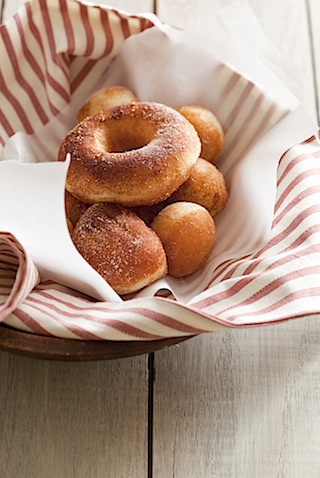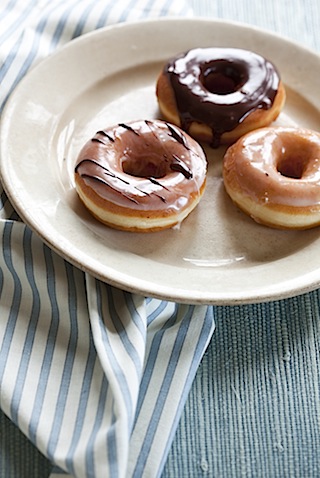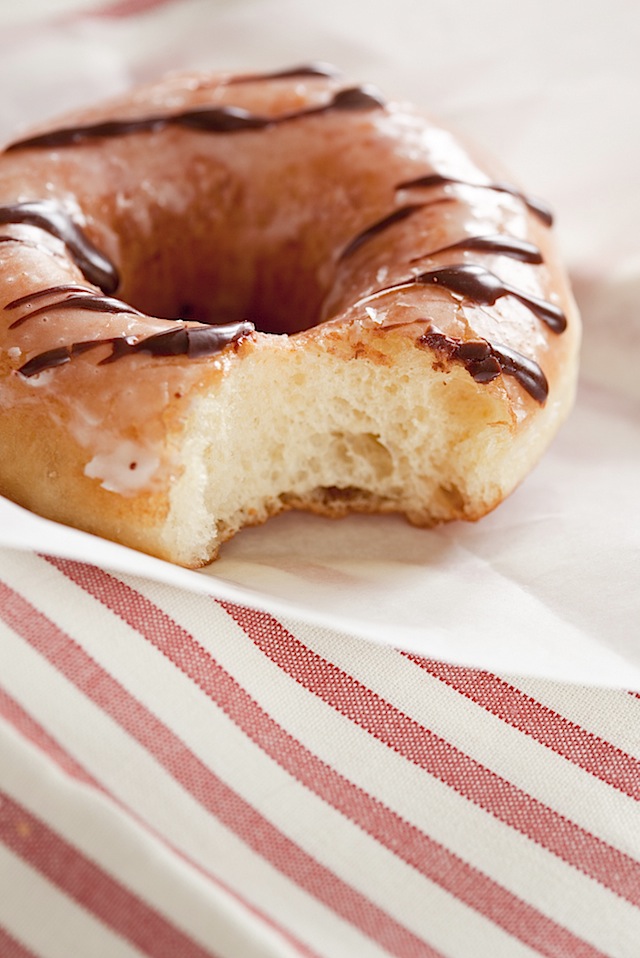Raised Doughnuts, V3.0


It seems that I can never quite be done with a recipe. A recent reader comment prompted me to dig deeper into why homemade doughnuts go stale so quickly, when the commercial variety can hang out at least for a day, if not more without becoming tough. My immediate thought: chemicals. Who knows what sorts of preservatives you can find going into the doughnuts of the big chain stores. Who knows? Well, in fact, you can know quite easily. It only took about 20 seconds for me to get the full list of ingredients in a Dunkin Donuts plain glazed. (I think it’s great that they do this, btw):
Enriched Unbleached Wheat Flour (Wheat Flour, Malted Barley Flour, Niacin, Iron as Ferrous Sulfate, Thiamin Mononitrate, Enzyme, Riboflavin, Folic Acid), Palm Oil, Water, Dextrose, Soybean Oil, Whey (a milk derivative), Skim Milk, Yeast, Contains less than 2% of the following: Salt, Leavening (Sodium Acid Pyrophosphate, Baking Soda), Defatted Soy Flour, Wheat Starch, Mono and Diglycerides, Sodium Stearoyl Lactylate, Cellulose Gum, Soy Lecithin, Guar Gum, Xanthan Gum, Artificial Flavor, Sodium Caseinate (a milk derivative), Enzyme, Colored with (Turmeric and Annatto Extracts, Beta Carotene), Eggs;
Yep, there they are. Those gums and preservatives. How can a home cook compete with that in terms of staying power? And yet, who wants to eat that?
Well, look a bit closer, and you’ll see another sneaky ingredient in there: soy flour. When I was researching gluten free varieties of doughnuts, I did a small amount of reading on soy flour in doughnuts. I was focused more on recreating the doughnuts without any wheat, so it hadn’t occurred to me that a bit of soy flour might in fact improve a traditional doughnut. Now, as I started looking more into what commercial producers use, I find that they almost all use some soy flour! Soy flour, it seems, reduces the oil absorption when frying and helps maintain moisture in the finished pastry. It also adds protein, which increases the nutritional value of the doughnuts. (still not exactly health food). If it does these things for the industrial doughnut, why not try it for the home one?

To try this, add 5 to 8 grams (a little less than 2 tablespoons) of soy flour (I used Bob’s Red Mill) along with the 300-400g of bread flour in the recipe*. It’s best to sift it in with the bread flour to break up any lumps and distribute it evenly, then proceed as normal. Once all the ingredients were in, I gave it a little taste test. The raw dough tasted beany to me. I happen to have a bit of a fear of bean flours of any variety. That beany taste just ruins most things for me. I don’t want it anywhere near my doughnuts. I was quite convinced I had completely ruined the batch. But, I kept with it, hoping that somehow, magically, it would vanish in the final product. The dough worked as it usually does… a soft, moist dough that handles better when chilled. It puffed beautifully during proofing, and fried up to gorgeous rings and holes. They looked perfect. In fact, they might have even looked a bit better than perfect. And, the oil? I didn’t measure, but I would swear there was more left in the pot than normal.


The big test was ahead: Did I just make icky bean flavored doughnuts? Or would they pass my taste test.

Oh, my. No bean to be found. The doughnuts are light and fluffy, with just the right spring. It’s been an hour so far, and they are still unbelievably good. Definitely less oily, which seems to be keeping the glaze that perfect set. Of course, they have to last another few hours for the true test. I’ll report back!
Update: An hour later – and the pastry is still soft. I covered them, lightly, with foil… and that seemed to perhaps trap in a bit too much moisture, so the basic glaze softened. The chocolate glaze, however, still looks great. Uncovering to see how they hold up that way.
Update: For last night’s late night snack, Cam and I munched down a couple. They weren’t the ethereal bites they were for the first hour, but they were still quite soft. The couple I had very gingerly wrapped in foil were slightly more moist. All still very edible. I left the remaining doughnuts laying on a baking tray with a light foil cover. This morning, they were pretty stale… not rocks, and definitely a bit softer than they have been in the past, but definitely had that day old feel.
Final Thoughts: Adding the soy made a small difference in the overall staying quality of the dough, but it isn’t a magic bullet. The bigger win probably comes from the doughnuts absorbing less oil when frying, which makes for a nicer overall pastry. While I still need to do some experimenting with the best way to store the doughnuts, particularly overnight, this is a trick worth trying!
*I used the original Basic Raised recipe from my book… but you can also try with my Raised Variation 2.0.
Hmm – this may be the death of me – the only thing that’s kept the pounds off is that when I’m out of town for a couple of days the donuts don’t keep….
Mmm they look amazing- you must have been pleased with the result! I hate looking at the ingredients of any junkfood that I’m eating, as it’s usually quite horrifying (so many ‘gums’ and oils). I can’t wait to try out this recipe 😉
Wow, thanks for the great tip. This inspires me to look into the effects of soy flour in baking…
OH. I could have doughnuts again!
Your doughnuts are always amazing! I will need to try v3 this weekend. And take pictures. And upload them. I use a little wheat starch or potato starch to keep cakes and breads softer for longer, never thought to try it in the doughnuts. But that is what professional pastry chefs use. It is easier to find Xanthan and Guar Gums these days, (used to be available only in very large amounts), they can be used in very small additions and allow the dough to rise more and stay softer. They are also available from brands that sell organic products. My issue with “store bought” doughnuts is cows milk, cows milk, cows milk and cows milk, they put four types of cows milk in them, and I’m allergic. With your recipes I can use almond/hazelnut breeze or rice milk.
That’s really good to know. I shall try adding soybean flour next time I make doughnuts. Thanks.
Yum and feel so inspired. Will pass along to my resident baker friend 🙂
These donuts look fantastic!
I’m going to note this to try when I get around to buying your doughnut book. Do report back to tell us how long the doughnuts can stay uncovered. Great job Lara!
Hi 😛
this is soo yummy!!!
I talked about you in this post http://maison-etta.blogspot.com/2011/02/mad-about-donuts.html
I hope you like it!
Kisses
Etta
I loved this post! We always automatically assume that ‘chemical’ or ‘scientific’ equal ‘bad’, above all in food; but using safe additives with a pinch of salt can produce better and equally healthy (ahem) results for the home cook as well. In the end, a lot of the granny’s tips have a scientific explanation.
I am always baffled at how the flavour of soy disappears. Not sure if it is related, but every time I make tofu, I always expect tofu or okara to taste like soy milk (which I hate), and they don’t!
Great post, everything about them. Can you please give us how much kcal will have this doughnuts? I just to compare with the industrial one´s. Thank you,
http://kitchenvoyage.blogspot.com/
What a great tip! Though I failed when I made doughnuts the first two times – I am not giving up! Maybe I will try this next time.
They look absolutely delicious. I must admit I rarely make it all the way through glazing, it’s all I can do to contain myself long enough to roll them in some sugar.
On my really organised and efficient days (few and far between) I hold back the water I’ve used to boil or steam potatoes and use that in place of about half the liquid in recipes for bread and doughnuts and it definitely keeps them fresher for longer.
Not that keeping doughnuts for any length of time is often a problem in this house.
You might also try a bit of liquid Lecithin. It is a natural product that has really good health benefits and acts like a preservative in baked goods. It is often subbed for the fats in a recipe but I prefer half and half just cuz I likes me some butter flavor! My breads last quite a few days as well as do rolls, and yes, even doughnuts. You will see Lecithin listed as an ingredient over at the D.D. site. I buy it on Amazon or the health food store.
I second all the potato comments and think this would make an interesting test: Potato flour, a few tablespoons of mashed potato and/or potato water? Potato bread stays fresh a long time. . .
this is so so awesome!! love them!! I will have to try the soy flour next time I make some!!
Lara, I’ve been hearing such great things about your book. Your video is adorable too. Need to get my hands on a copy of it. 🙂
Hi! I got busy at work and just got back from an office seminar…I got excited on the update part of your experiment after that I tried it on my own and was pleased with the results that after an hour my doughnuts were still soft actually they were still soft even after 2hrs. Now were getting somewhere in our quest for the softest doughnut even after 24 hrs hahaha. Thanks a lot Lara for the tips and for taking the time to make experiments on my problem about stale doughnuts…you inspire me…and will be following closely on you future experiments on doughnuts.
Hi Lara,
Thanks for the info on soy flour, I’ll definitely give it a try – if only for less oil absorption. Here’s my trick for keeping donuts fresh….FREEZE them. It totally works; although messy toppings can be a problem. Place cooled donut in a ziplock freezer bag. Suck the air out of the bag with a straw, while you seal it shut. To defrost, just place frozen donut in it’s bag on kitchen counter. It’ll take a couple hours to defrost. Delicious as the moment it went into the freezer. I have been doing this with store-bought donuts for years. Now my homemade donuts are good enough to merit preserving too.
Can you tell me the roll that eggs play in the yeasted dough?
This is probably a late answer, but I am also posting for anyone that might be interested in the future. Eggs (specifically yolks) have emulsifying properties, which means that they help oils/fats and water ‘bind’ together. Another source of emulsifiers is soy lecithin, which is contained in soy flour, and it might be the reason behind this whole post’s experimental results.
Soy flour, who knew?? I’m almost afraid of trying these. If I made a whole batch I swear I’d eat until I exploded OR I’d end up with an ass on the front as well as the back! LOL
Thanks for doing all the crafty research and experimenting.
Hi Lara,
I just purchased your book and I’m really looking forward to making some doughnuts! Can you please tell me how to make colored glaze? There is a lovely picture of an adorable pink covered doughnut on the introduction page of your book, but I don’t see where the instruction is for pink glaze. Can you tint a basic sugar glaze with food coloring, or does it come out too translucent? Thanks!
Hi Stephanie,
The pink frosting in the photo is simply the cream cheese frosting recipe with some jam mixed in… it’s really tasty. I typically use raspberry, but you could use strawberry or grape and get a nice color and flavor. You could potentially do something similar with the glaze recipe, but use less milk (or water). It might be a bit too thin to really show the color, but I bet it would be tasty.
Hope you enjoy the doughnuts!
-L
Thanks, Lara! I’ll give that a try and let you know how it turns out!
Lara,
I see the posts are from last year so I’m not sure if you’re still tracking this. If so, would the conditioner I make for my whole wheat bread work? It’s a combination of vinegar, vital wheat gluten, and potato flakes. It makes an incredibly light whole wheat loaf. Thanks!
Hi Stacy,
The doughnuts are super light, but they just don’t hold up quite as well as I’d like. I’m not sure the dough conditioner would help with that, but I suppose it could. It’s certainly worth giving a try.
Lara
Generally I hate cooking. But suddenly what happened I don’t know, I have started preparing by using this recipe. My parents they shocked, because it taste good and I have tried it. Thanks. Benefits Of Lecithin
Hey, I recently bought Doughnuts Cookbook, 90 simple and delicious recipes. I have one question, how could you make donuts less rough and bumpy when you fry them with oil?
Hi Jordan,
Are you making cake or raised doughnuts?
Lara